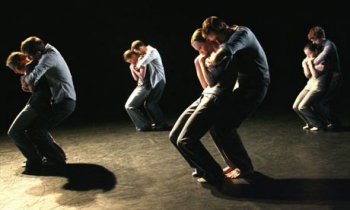
|   |

|   |
Where did they lose all the color? - Veejay Sai, Bangalore e-mail: vs.veejaysai@gmail.com January 26, 2013 A rather early weekend began with the Scottish Dance Theatre (SDT), the national contemporary dance company of Scotland premiering their works in India on a four-city tour. Presenting three of their works as a part of The British Council’s annual festival, they visited the garden city of Bangalore in South India. Bangalore, the new cultural capital in the south, attracted the National Dance Company of Wales with overwhelmingly packed halls last year. The current festival was in collaboration with the Indian Council for Cultural Relations, the group was brought to the city in collaboration with the popular newspaper The Hindu. The current tour was in consultation with artistic director designate Fleur Darkin.  Scottish Dance Theatre
The evening opened with the first piece titled ‘Drift’ choreographed by James Wilton. The opening sequence shows a lone male dancer (Matthew Robinson) in a contemplative mood. With meaningless gyration as he goes about the stage, he is joined in by his fellow-dancer (Natalie Trewinnard). In a rather disconnected abstraction both of them fall into a strange synchrony. If the core idea was to keep bracing each other off the ground as a gesture of anything remotely creative, they might as well have renamed the piece ‘Lift’. They even had a pause for three minutes. In exasperation, one can say the pause was a lost cause. Bereft of any soul, this highly engineered piece made for a tame opening to what one would expect was a good evening. The second performance ‘Dog’, a 31-minute piece was choreographed by the renowned Hofesh Shechter. “So what is the big deal about these guys jumping around in dull ash grey pajamas?” prodded a friend who I tagged along to the show. Monotony was the other name of this piece. Dressed like a bunch of tired factory workers, they did everything but collapse on each other. The piece opened with the voiceover of the story of dolphins. “Once upon a time 100,000 years ago….” as the story went on, one couldn’t help but smile at the immaturity of this whimsical juxtaposition. “It’s not the end,” continued the voiceover before the dancers indulge into a meaningless chaos. As the sequence developed, four male dancers began looking for their objects of desire. The dance of whales and dolphins, the puppetry mime and other themes collided with the music. Groups of dancers swiveled, fell, hammered their fists to the floor, bent over backwards and basically strung together all sorts of movement in an excited spur of trivial anticipation. In this case, the music was probably what held the narrative more cohesively than the dance. Which is no great compliment for the choreographer as much as it is for the music editor who smartly knit excerpts from Fan Farra, Braziliero by Sergio Mendes, Verdi, Bach, Aleph and others to a sensible design. The music, high on testosterone didn’t match with the dance on the stage however. Going through the credits you learn that Phyllis Byrne hasn’t contributed much in terms of costume design. If body-configurations were the sub-text of this piece, why weren’t the dancers showing obvious skin? Why were they dressed to look dreadfully bland? Dull ash grey in bright white lights? “Where is all the color that Scotland takes great pride in?” questioned a connoisseur sitting in row one. A point driven home. Was this the same choreographer who gave ‘Violet Kid’ and ‘Political Mother’? The brochure announced ‘Dog’ was ‘honest and raw’, ‘witty and sophisticated’. Almost all these qualities were possibly there in the production, but rather invisible.  Dog  Luxuria After an interval, the second half of the evening consisted of a 33-minute piece of choreography titled ‘Luxuria’ by Liv Lorent. So how new is the idea of eroticism in western dance? ‘Luxuria’ just about made up for the evening, which would have otherwise been wasted. A slight dash of pastel colour on the costume by Paul Shriek gave some visual relief to the production. Girls dressed in stiff hoop-skirts prancing about like possessed dolls and the inevitable physicality in the chemistry of the dancers lacked originality and was bereft of any soul. If it was about pushing one to the edges even in movement, why take comfort in stereotyping? Liv’s choreography for this was at best straight out of the 1940’s war flick with the engineered cheer and gusto just apt for the screen. The arrangements seemed posed and the remarks far more rehearsed than necessary. What could have otherwise been a rapturous detonation of creative exploration, ‘Luxuria’ turned out to be a bit bland for what it was perceived to be. The Scottish Dance Theatre could certainly keep more significant markers and display better choreographic works when they travel on such prestigious international tours. The British Council could do with some more discretion in their programming for what the discerning and serious Indian audiences would like to see. Veejay Sai is a writer, editor and a culture critic. |